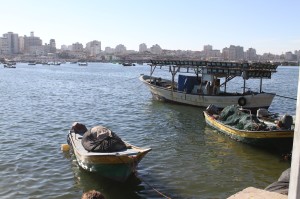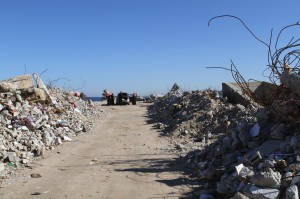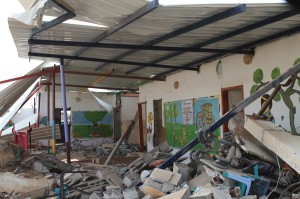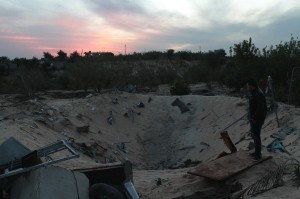Friday in Gaza (Day Six) by Gerri Haynes, photos by Bob Haynes
Operating rooms and clinics are closed on Fridays – the holy day.
A few of us started our day with a visit to the Gaza seaport. Gaza rests along the Mediterranean in what could be one of the most beautiful places on earth. The water was sparkling and the sunlight was warm as we walked along the breakwater. What is not seen: fishermen are allowed to fish only three nautical miles from the shore – in water that is shallow and polluted by the tens of thousands of tons of sewage deposited daily from Gaza into the Mediterranean.
The ceasefire of August promised that the sea access limit patrolled by Israel would be increased to six nautical miles – but this has not happened. I had asked what was happening to the rubble concrete from destroyed buildings. At the port, we saw increasing walls of that rubble deposited on the sea wall. The volume of rubble from the many thousands of bombed buildings will require far more space than that available along this sea wall though and I wonder how it can be used.Our group then traveled by bus to have an overview of the current situation on the ground in Gaza. Hamada El Bayeri of UNOCHA joined us for two hours in the northern area. Hamada has guided our tours of Gaza on previous trips and we learn from his knowledge and wisdom.
Today, we returned to Shujayea to further understand the devastation of this summers’ attacks. Hamada talked about the need for Palestinians to be regarded as equal citizens of the world. Two weeks ago, Israel announced that Gaza would be allowed to export produce to the West Bank. Restrictions on fishing and the “off limits” areas along the border with Israel (35% of Gaza’s arable land) make production of salable items difficult. Hamada made the plea that we are hearing throughout Gaza: “We need to have equality and dignity.”
Having the world provide fish is not the answer; fishing for themselves and producing food is the answer. “We just want a chance.” Many educated people in Gaza are without jobs. Talented people engineered the production of tunnels. Hamada noted that if a Microsoft plant or other industries were available for workers in Gaza, tunnels would not be needed.One of the remaining dangers of the summer attacks is the high number of unexploded ordinance in the debris of destroyed homes. Last week, a four-year-old was playing in the remains of his home and was killed by the sudden explosion of one of the bombs. Approximately 15% of the 70,000 bombs that fell on Gaza during the summer are estimated to remain – so far – unexploded. Testing for the presence of toxic substances such as uranium 238 and other heavy metals from exploded bombs has not yet begun.
This afternoon, we journey to Khan Younis in the southern part of Gaza. Hosted by the family of a young man, Mohammed, now living in the United States, we toured through the area of Elzana, Khuzaa, Abasan and Bany Suhaila. In these border towns, Israel leveled many homes, mosques and businesses.
We ventured near the “no go” zone, and were told that Israel has agreed to allow farmers to enter this area. However, with many of us standing at the edge of the zone, it seemed we were threatening and a warning shot was heard. We quickly retreated.A twelve-year-old boy from our host family traveled with us to these towns and related that he has lived through three wars. This war, he said, was the worst – an assessment made by everyone we speak with. He was awakened one midnight by a bomb blast that struck a neighbor’s home. He and his family ran quickly to the neighbor’s house to discover nine people had been killed.
We enjoyed a dinner with Mohammed’s friends and family members then traveled again to meet with an Al Aqsa University professor. We wandered through his beautiful vegetable and fruit garden and were amazed by the production of food in dense, sandy soil. We were shown an enormous bomb crater and the early structure of a home being built to replace a garden home that was nearly completed when it was destroyed by a bomb.
To end the day, we were taken to a private basement museum and treated to classical Arabian oud music by a local group – music and culture surviving through war after war.
RSS feed for comments on this post. TrackBack URI



